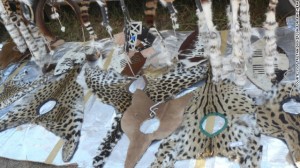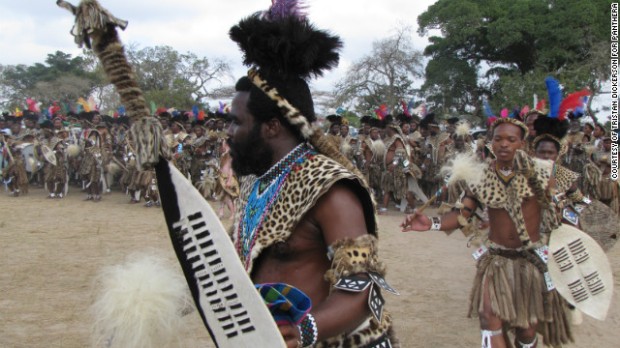Wild Leopards Threatened by Religious Tradition in Africa

CNN (Nkepile Mabuse and Vanessa Ko)
A growing religion in southern Africa is posing a threat to the survival of wild leopards.
For the Nazareth Baptist Church, also known as the Shembe, leopards are seen as a symbol of pride, beauty and wealth, while their skins are viewed as essential attire for church elders who wear them around their necks during traditional ceremonies.
A mixture of Christianity and Zulu culture, the Shembe is one of the biggest traditional religious groups in South Africa with around 5 million members. There are fears from conservationists that as the church grows, Africa’s leopards, already listed as “near threatened” by the International Union Conservation of Nature (IUCN), will be pushed towards extinction.
“From visiting a few of these (church) gatherings, you realize that it’s not 92 or 100 or 200 (leopard skins). We are talking about thousands of leopard skins,” said Tristan Dickerson, a conservationist at the Phinda Game Reserve in KwaZulu-Natal province.
Dickerson first found out about the Shembe in the course of helping with a police investigation, after a pile of at least 92 leopard skins was uncovered during a village raid. Many of those skins had been tailored into clothing meant for the church group.
Besides being killed by farmers trying to protect their livestock, 150 leopards are legally targeted by trophy hunters each year. But increasingly poachers kill them to profit from their use in traditional medicine and ceremonial dress.

Dancing at a Shembe gathering. For the Shembe, leopards are seen as a symbol of pride, beauty and wealth.
“What we are finding is that they are actually being targeted, instead of it being by-catch from the illegal bush meat trade,” Dickerson said. “They are actually putting poisons out to target leopards because there is such a high demand for leopard skins now.”
The feline species is protected by the Convention on International Trade in Endangered Species, or CITES, and the sale or possession of its parts is illegal in South Africa. Those who wear it as traditional gear, including Zulu royalty and high-profile individuals like President Jacob Zuma, are required to have permits issued by the state. But at Shembe church gatherings, trade in skins is done openly with no law enforcement.
Dickerson’s attempt to solve this conflict of tradition and conservation has taken him to China where he has been trying to find a suitable fake fur alternative for church members.
“I went to Beijing and spent a week there, meeting with factory representatives to try and develop this fur into the level that was needed and the quality that was needed,” Dickerson said.
And the quality is crucial, because while the church’s leadership has warmed to the concept of fake leopard skins, they still have to approve of the product. Dickerson says the church’s followers will only be converted to fake items if the leaders say it is acceptable.
On a recent trip to Ekuphakameni, South Africa, where the church was founded, Dickerson visited a church gathering and showed his fur samples to a senior preacher.
“It’s beautiful, but it’s not the real thing,” said the preacher, Mhlanubanzi Mjadu. “It’s like a blanket. After some time, it will wear out. Real leopard skin can last for more than 20 years.”
Mjadu said he had no idea trade in leopard parts was illegal, and he did not know that the leopard was a threatened species. He said that as an elder he could not wear a fake costume, but he could see a place for fake fur in the church as membership continued to swell and the prices of leopard skin seemed to be rising. “It will help the congregation and protect the leopard from extinction,” he said.
Dickerson is also hoping that church followers who cannot afford the real thing would find the cheaper version an enticing alternative, but so far they have not shown enthusiasm. At the gathering in Ekuphakameni real skins were being sold for $440 each.
“We are improving the product as we speak,” Dickerson said. “If we can get one of the leaders to wear one of these things and say to the people, ‘This is accepted from now on, we do not wear real leopard skins anymore, we have an alternative,’ that statement… would be the pinnacle of this whole project.”



